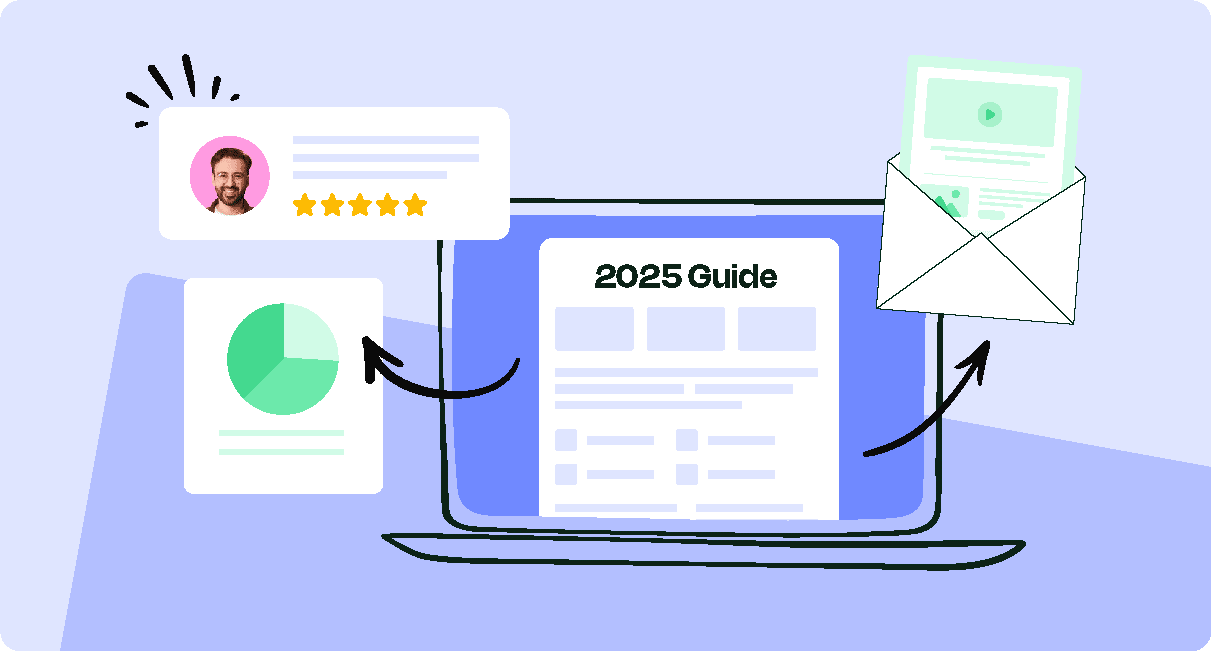Internal communicators work hard to provide employees with relevant and timely updates, but things don’t always go as planned. Resolve internal communication challenges in your organization quicker by coming prepared with these strategic solutions.
Internal communication problems affect every aspect of your business. Communication flows are disrupted, updates are missed, confusion builds, and employees struggle just to stay productive, let alone do their best work.
To avoid long-term internal communication problems, you need to be proactive. Get a comprehensive internal communications plan and internal communication strategy in place, but make sure you also understand the common causes of problems in internal communications so you know what to do when things go wrong.
In this post, we’ll break down the most common internal communication problems and how to approach them. We’ll also show you how ContactMonkey can be used to simplify and streamline some of these internal communication solutions. Ready to improve the performance of your overall internal communication system? Want more clarity when it comes to all things internal comms? Then check out our guide on internal communication research that covers key topics and questions to ask.
Book a demo to find out how ContactMonkey’s internal communication software features can help you minimize internal comms challenges.
Take a self-guided tour of ContactMonkey
See how our key features can streamline your internal communications.
Take product tour

The Potential Impacts of Internal Communication Challenges
Poor internal communication can do serious harm to your business. But because internal communication problems don’t cause damage to a company in one big swoop, you don’t feel the impact of these problems immediately.
Instead, internal communication issues are more of a domino effect. A lack of information and resources causes poor employee morale. When morale is low, the work suffers. In fact, research shows that disengaged employees have a 37% higher absenteeism rate, resulting in 18% lower productivity and 15% lower profitability. Over time, employees get fed up and you see broader issues with employee retention.
Here are just a few of the other negative impacts of unresolved internal communication challenges:
- Increased employee stress and poor employee wellbeing
- Decreased employee motivation
- Decreased productivity
- Increased turnover
- Ineffective customer service
- Decreased customer satisfaction
- Product defects
But the news isn’t all bad! Since these impacts come about gradually as issues accumulate, a motivated communicator has the opportunity to figure out how to solve internal communication problems before they lead to serious consequences.
Modern internal comms and measurement tools
No design or technical expertise needed. Save time, increase engagement, and dazzle your employees with fun and interactive communications.
Explore all features

Common Internal Communication Problems and How to Solve Them
Internal communication is all about getting the right information into the right hands at the right time. But when there’s an obstacle anywhere along the chain, a small internal communication problem can snowball.
Below, we’ve provided common examples of internal communication challenges, tips for tackling them head-on, and insights on using ContactMonkey to figure out how to fix internal communication problems before they get bigger. So whoever owns internal communications at your organization, pay close attention.
1. Insufficient communication technology leads to ineffective communications
Companies settle for outdated internal comms tools that have limited functionality, are built for external communication, or are not optimized for all devices. Maybe they insist on sending internal newsletters using an external tool like Mailchimp, which can result in crucial communications ending up in the spam folder or even creating security vulnerabilities.
Without the right tools, communicators and team members alike struggle with time-consuming and inconvenient communication processes. Information gets lost, and frustration mounts.
Even when messages arrive without issue, limited communication tools inspire limited engagement. A plain text email, for example, will always get less interest than a dynamic and visually-impactful HTML email.
Solutions:
- Choose internal comms-specific tools that meet both your specific needs and those of your security team.
- Limit onboarding friction and ensure buy-in by choosing tools that integrate with channels employees already feel comfortable using.
- Collect internal communications tracking data to learn your problem areas, monitor improvements, and show the ROI of new corporate communication solutions to higher-ups.
How ContactMonkey Can Help:
- ContactMonkey’s simple all-in-one internal email software integrates with your existing Outlook or Gmail inbox and can push newsletters to your Microsoft Teams channels. You can also use employee SMS to reach employees with urgent updates.
- Communicators and employees can continue using channels they’re familiar with but gain increased functionality.
- Azure Active Directory and HRIS integrations help make sending more manageable with dynamic, synced distribution lists.
- Using the responsive email template builder, you can create beautiful, responsive HTML emails in minutes. Add images, GIFs, videos, and more to keep employees’ attention.
- Unlike with external marketing tools, emails are sent through your internal servers for increased internal communications security.
- ContactMonkey’s detailed email analytics help you understand how employees are engaging with your communications and show ROI on your internal communications investment.
Create and send employee surveys for feedback
Engage staff with pulse surveys, eNPS surveys, reusable surveys, custom polls, and more. Ready to send modern emails?
Explore survey features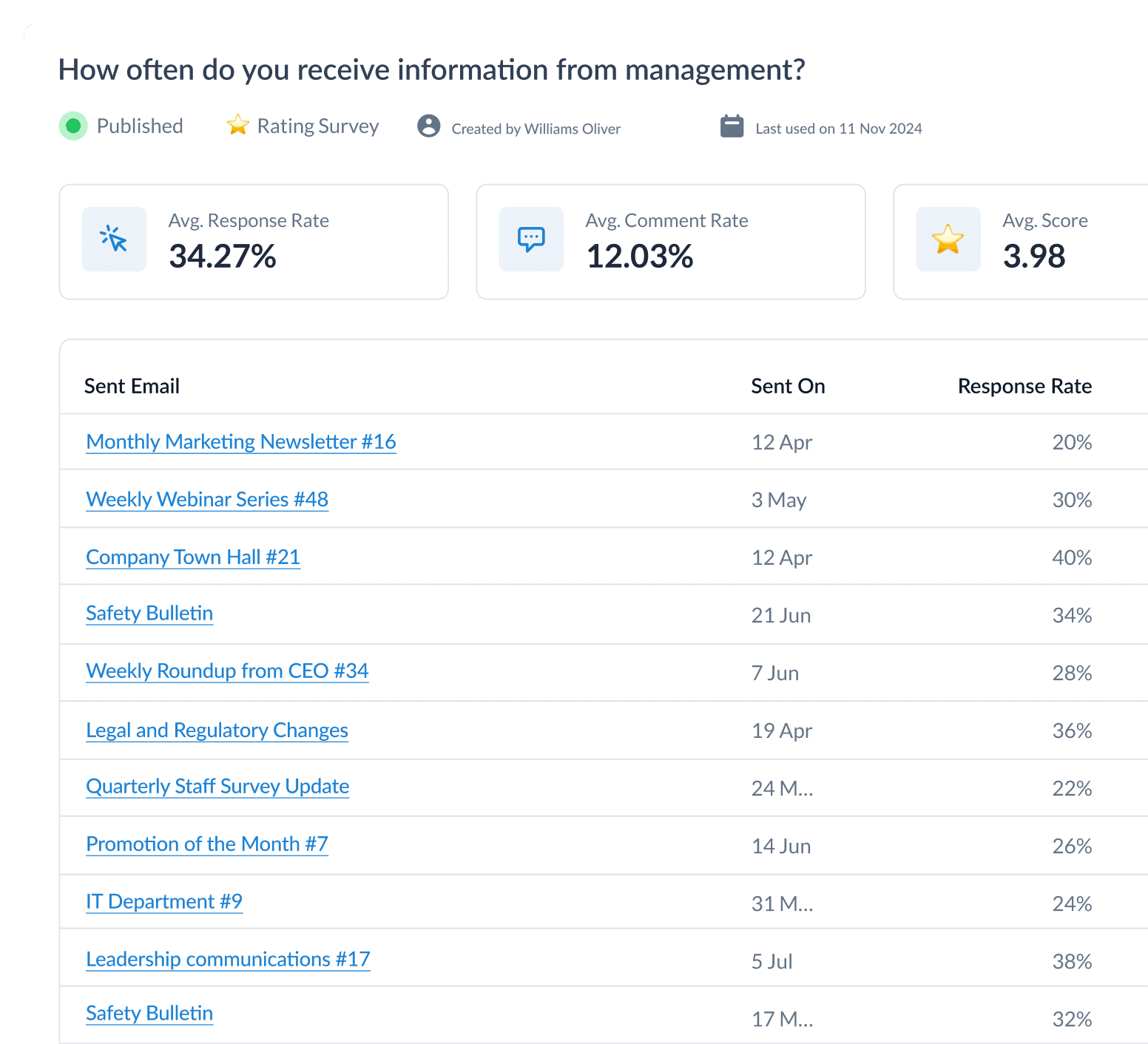
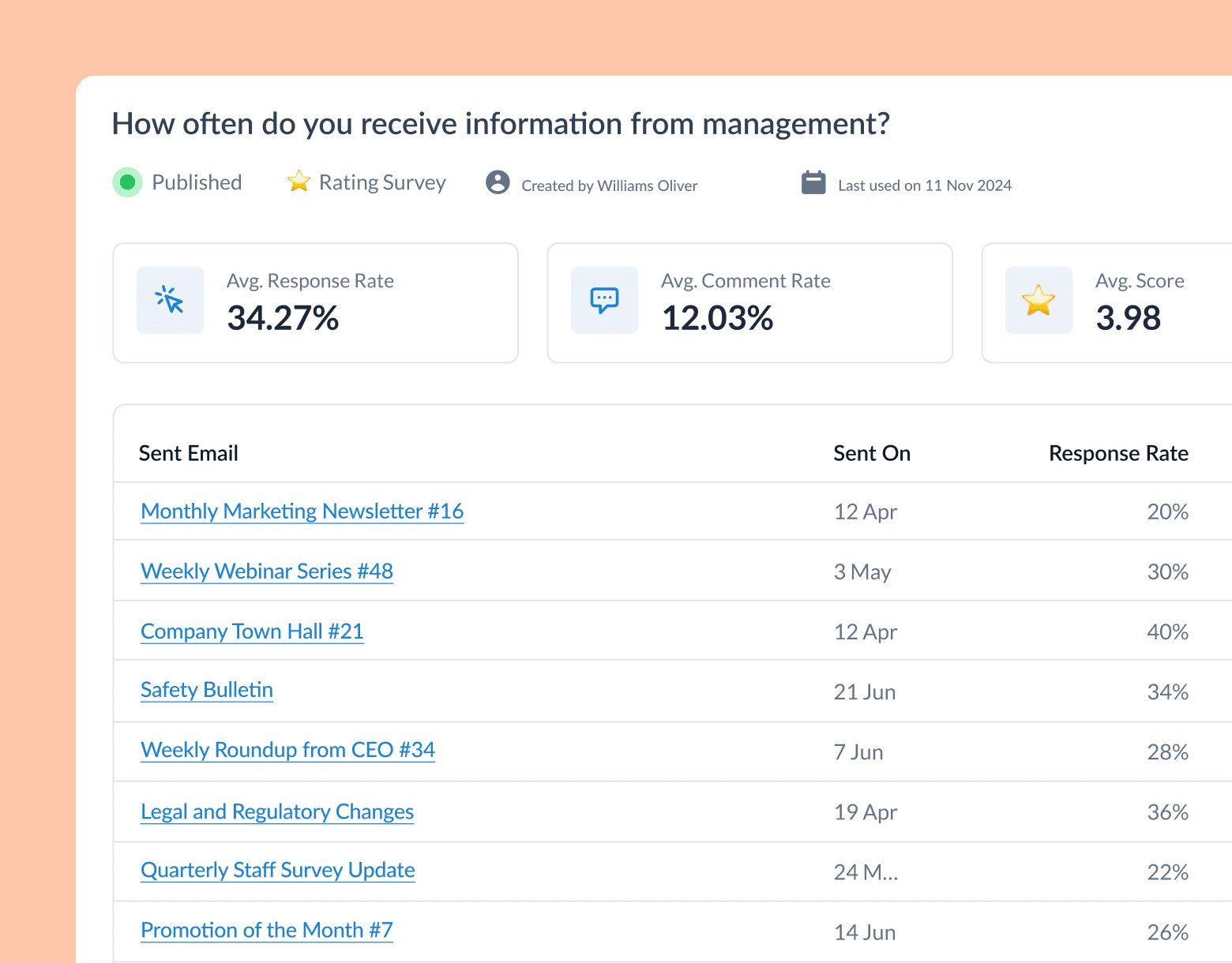
2. Limited employee feedback keeps communicators in the dark
Communications and HR professionals always want more employee feedback. Without it, they can’t know for sure what impact their communications are having.
Plus, open and honest feedback is a great indicator of employee engagement. Engaged employees want to participate and are happy to share ideas and solutions.
A lack of feedback, on the other hand, hints at poor engagement but provides no information on how the problem can be fixed. Not only that but employees feeling unheard can itself be the driving factor of poor employee engagement.
Solutions:
- Use feedback tools and surveys to give employees easy ways to have a voice.
- Prompt increased feedback with shorter, more frequent surveys. Check in with employees weekly and monthly, not just in an annual company survey.
- Send out low-stakes fun employee surveys to get employees more comfortable with sharing.
- Provide opportunities to share feedback anonymously.
- Publicly celebrate occasions when employee feedback leads to tangible improvements.
How ContactMonkey Can Help:
- ContactMonkey’s embedded survey features let you turn any email you send into a pulse check survey. You can collect quick, regular feedback without overwhelming employees.
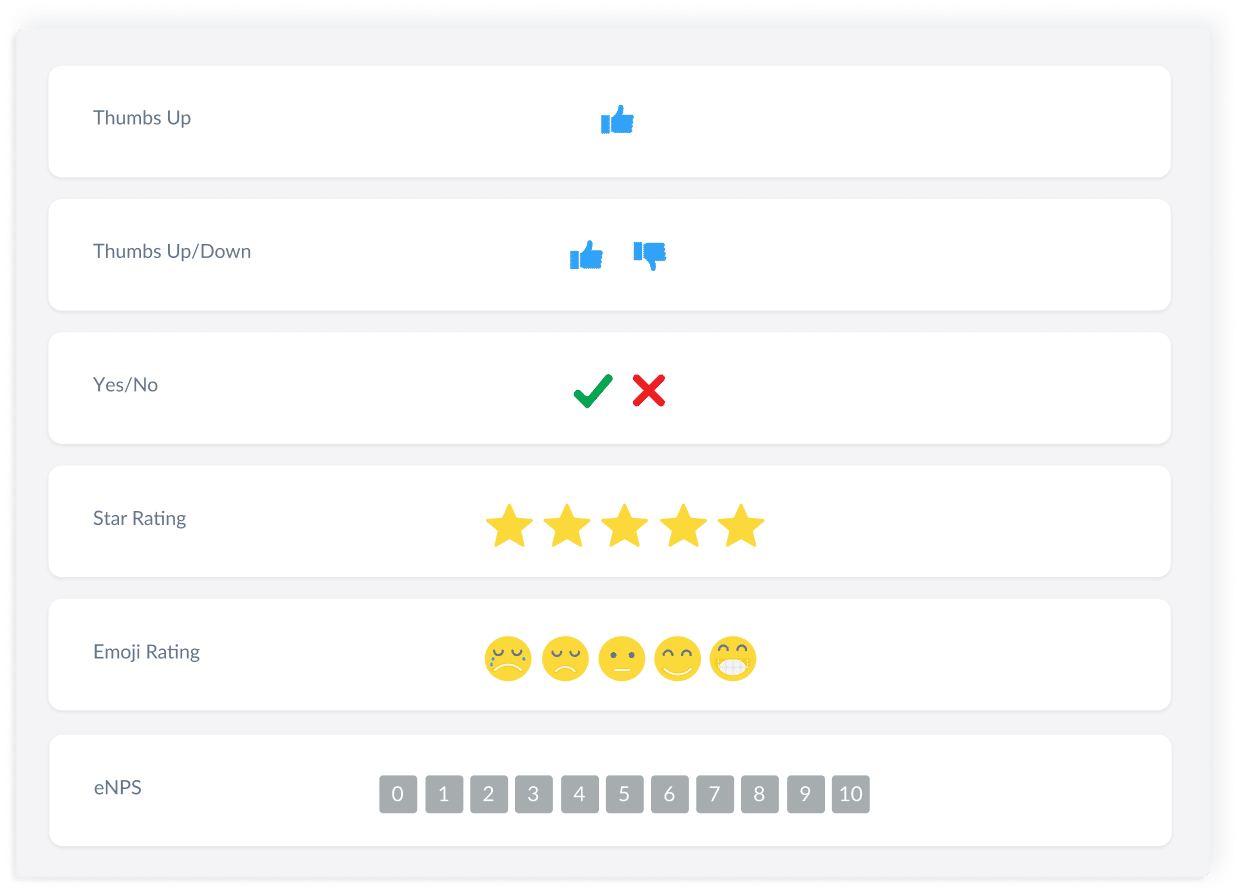
- Choose from multiple survey options, including star ratings, emoji reactions, yes/no surveys, and eNPS.
- Receive honest responses with the anonymous feedback feature.
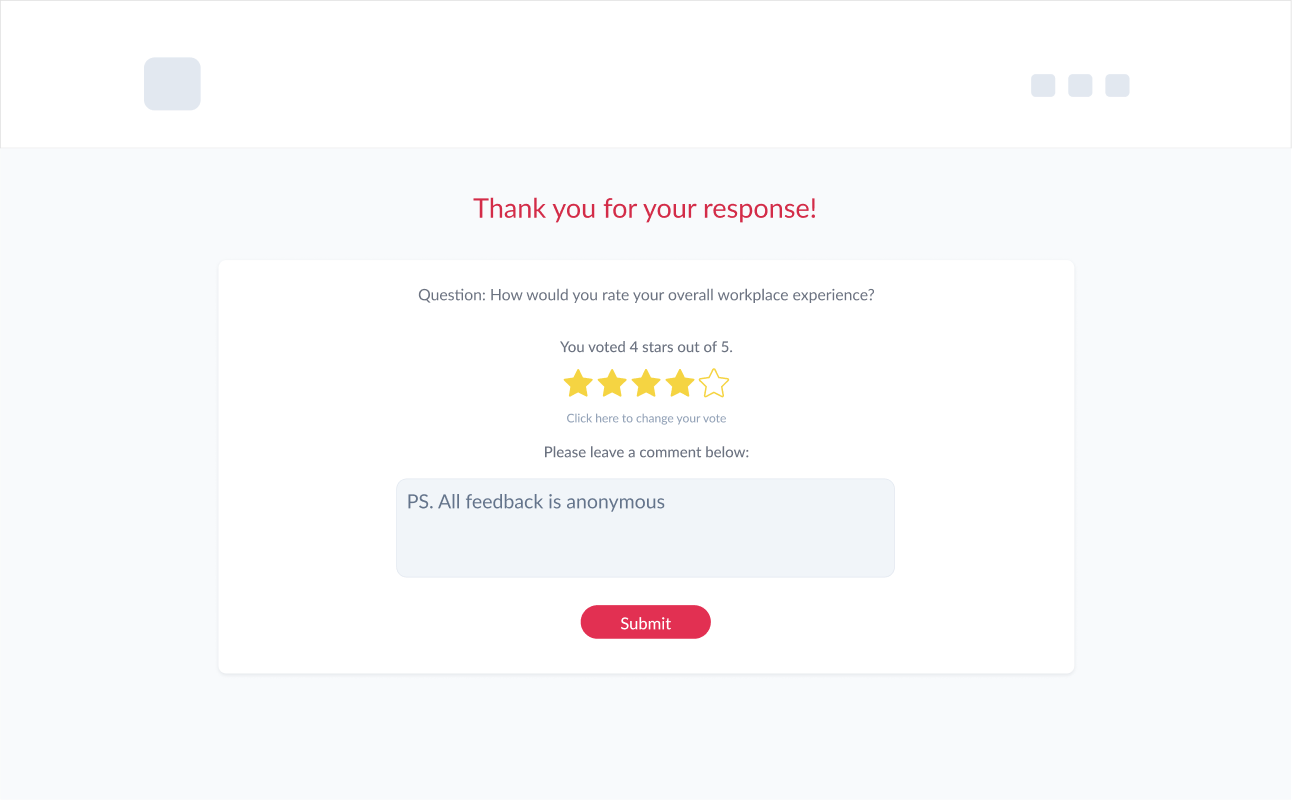
Get powerful email analytics and reporting features
Know exactly who is opening and engaging with your employee communications and company newsletters.
Explore analytics & reporting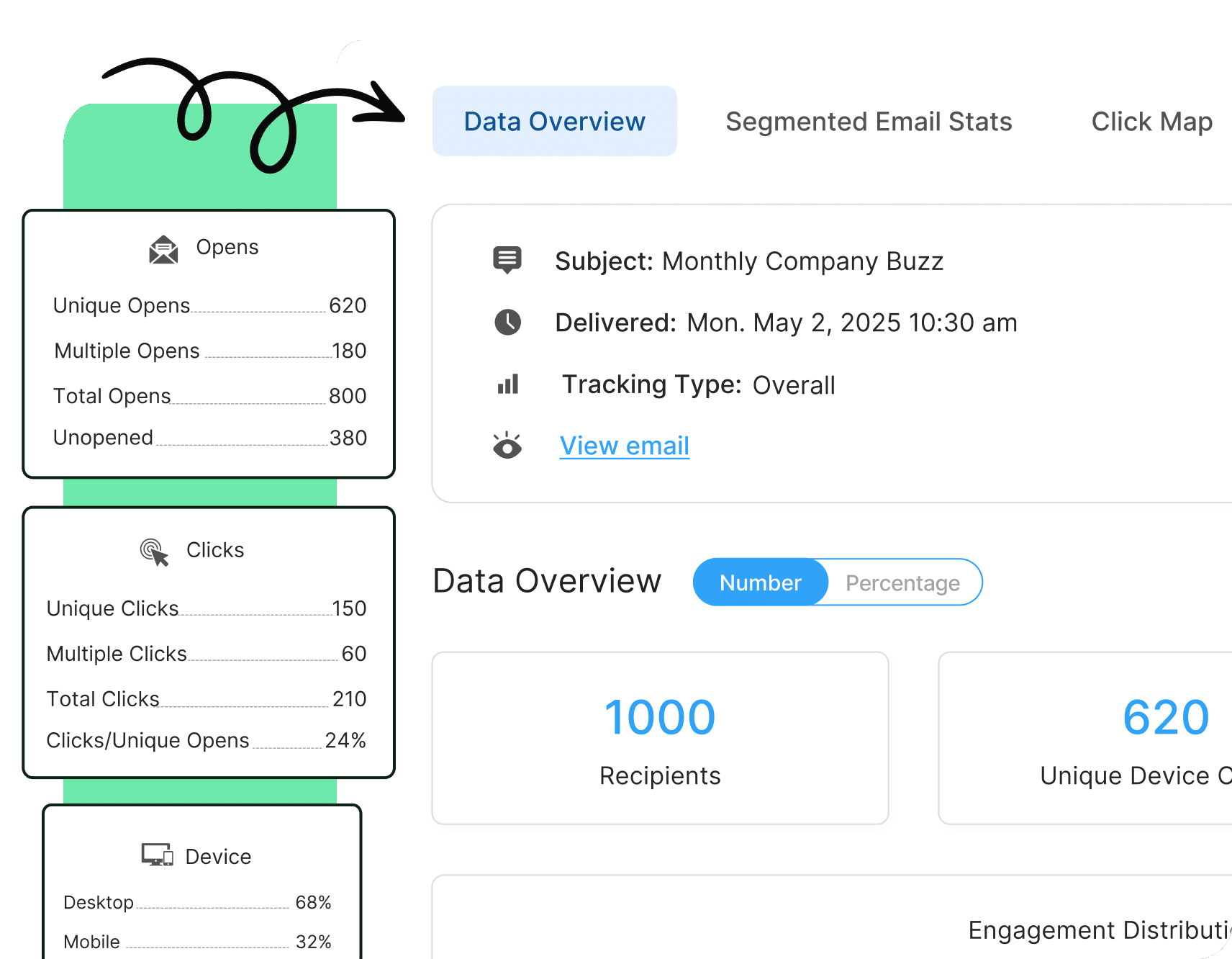
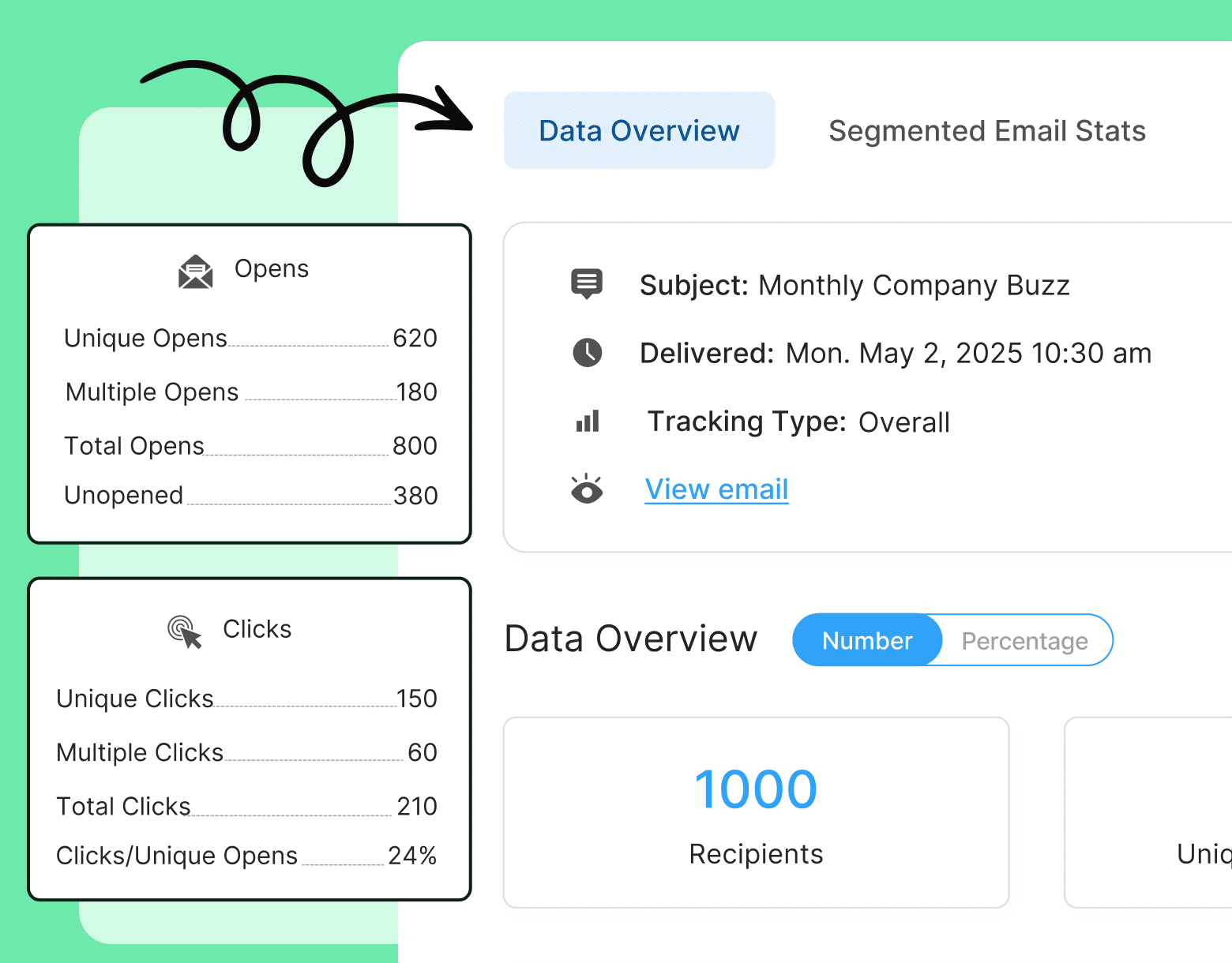
3. No internal communication analytics means strategizing with no data
Say you’re working on an initiative to improve workplace safety. You’ve sent out a company-wide email with documentation, digitized safety forms, and created mobile checklists. You’ve done your part—but if you can’t track internal communication metrics, there’s no way of knowing if employees even opened your messages, let alone read them.
Solutions:
- Use email tracking software and other internal communication tracking tools to track engagement and understand how employees interact with your newsletters and other corporate communications.
- Review email analytics to see what content types inspire engagement and incorporate these insights in subsequent emails.
- Track improvement over time and present results to leadership to ensure continued buy-in for tracking tools and internal comms as a whole.
How ContactMonkey Can Help:
- You can track every email you send using ContactMonkey. Choose between Individual, Anonymous, or Overall tracking and see detailed analytics about how employees are engaging with your emails.
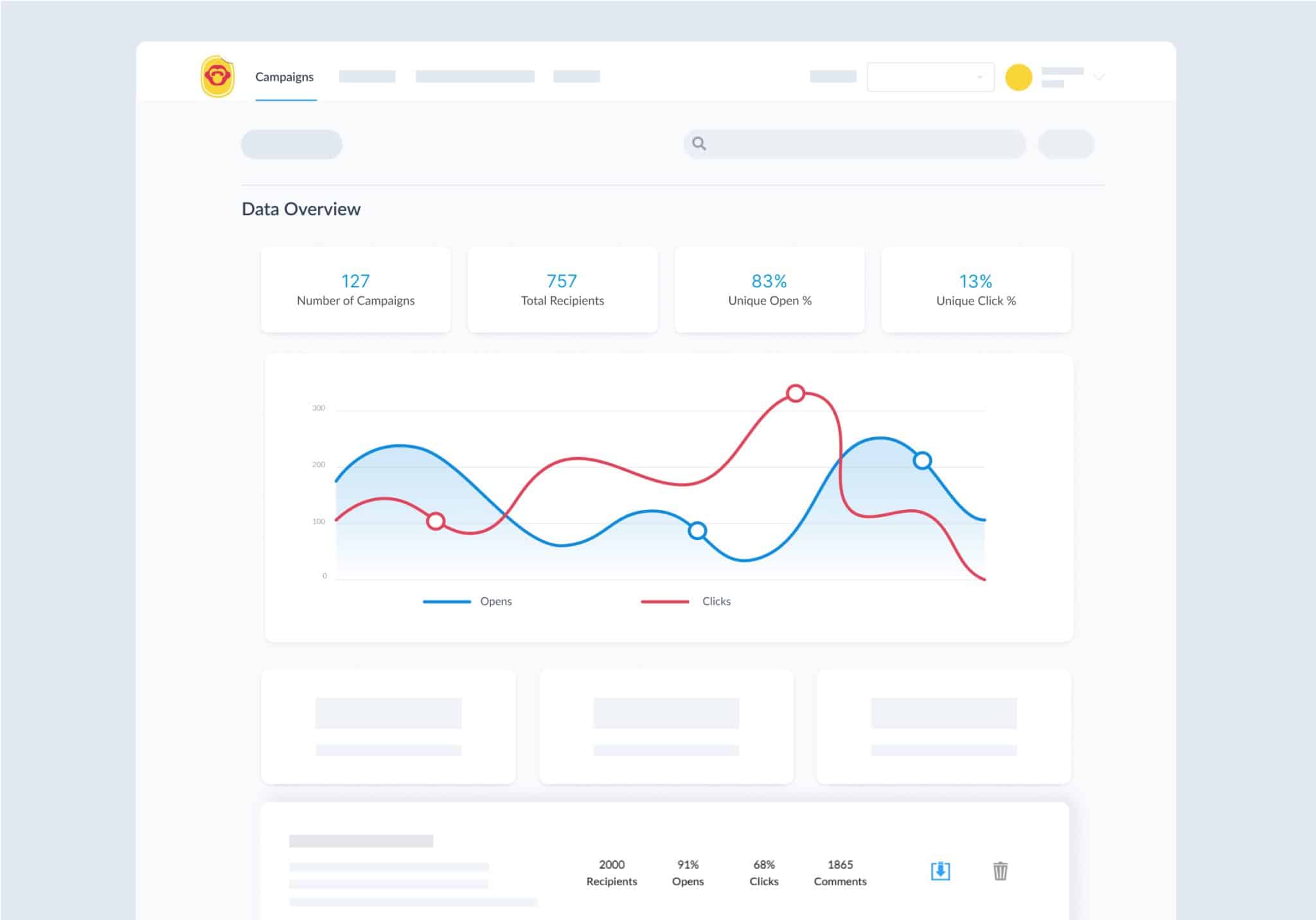
- You can view:
- Open/click rates, including a full click map
- Read time
- Survey responses & eNPS scores
- View detailed campaign comparisons to track quantitative improvement over time and export your results to show decision-makers. You can also consult our Internal Email Benchmarks Report to demonstrate how your communications currently stack up against others in your industry.
Watch ContactMonkey LIVE in action
Join live demo

4. Remote employees feel overlooked
Engaging remote employees may be a challenge, but failing to do so is not an option!
Without a concentrated effort to integrate remote employees into company culture, activities, and communications, said employees feel isolated, out-of-the-loop, and undervalued. Their work suffers, projects stall, and eventually, they move on to other opportunities.
Solutions:
- Be proactive. Establish a regular cadence for your remote employee communications and stick to it. Solicit ongoing feedback from remote employees to identify and head off any remote work communication challenges that may arise.
- Find ways to engage with remote employees on a personal level. Celebrate their wins and milestones, feature them in company-wide communications, and make sure they’re part of the social community within the workplace (see next point).
- Plan events for remote employees. Provide alternatives for in-office events that they are unable to attend and schedule regular virtual events to ensure remote employees feel connected to each other, their in-office team members, and the company as a whole.
- Be thoughtful about time differences. Choose channels that are appropriate for asynchronous communication and segment sending to reach remote employees when they’re most likely to see your messages.
How ContactMonkey Can Help:
- With ContactMonkey’s pulse survey features, you can embed short survey questions in emails to remote employees. Collect feedback on remote employee happiness and identify problem areas and internal communication barriers early on.
- Merge tags in the subject lines and body copy of emails can personalize them for individual employees, increasing open rates on communications.
- Event management allows you to build events directly in your ContactMonkey dashboard, design custom registration forms, and embed events in your emails. Remote employees can RSVP to virtual events directly from their inboxes, and event planners can track registrations and collect additional information that they need from attendees with the custom form fields.
- Using ContactMonkey’s list management capabilities, you can segment sending lists to reach only remote workers. Share remote-specific information, schedule sending according to time zones, and send targeted invites to virtual events with ease. Plus, through Azure Active Directory or HRIS integrations, employee lists are dynamic and update automatically, so you never have to worry about a remote employee slipping through the cracks.
5. Limited internal communication budgets become limited internal communication results
Internal communications directors often struggle to get bigger budgets, especially when their company’s internal communications budget comes out of the marketing department’s.
With limited resources to go around and despite internal efforts having a direct impact on external results, internal marketing gets put on the back burner.
Solutions:
- Use internal communication software solutions to help you make the most of limited resources.
- If you don’t currently use any dedicated internal communication solutions, build a business case for investing in internal communications software to present to decision-makers. Be clear on the specific internal communication issues the software will address. We recommend consulting ContactMonkey’s free Internal Communications ROI calculator to demonstrate the value of investing in employee engagement.
- Gather data and track patterns over time so you can show the quantitative benefits of your internal communications efforts.
How ContactMonkey Can Help:
- With ContactMonkey, you’re not only able to gather in-depth analytics but also compare campaigns side by side. Identify growth over time, and gather other insights to help you make informed plans.
- When presenting to leadership, you can easily export your ContactMonkey dashboard to a PDF or PowerPoint to demonstrate your results in a more engaging way.
Take a self-guided tour of ContactMonkey
See how our key features can streamline your internal communications.
Take product tour

6. Lack of transparency and leadership communication destroy employees’ trust
When company leaders withhold information rather than prioritizing effective leadership communication, employees have to rely on word-of-mouth for information that is crucial to their job responsibilities.Priorities become misaligned and projects proceed without necessary context, costing the company time and money. Eventually, frustrated employees simply lose confidence in management.
Plus, a lack of open communication from higher-ups makes employees less comfortable asking questions, so internal communication barriers and bottlenecks proliferate across the company.
Solutions:
- Foster a company culture of transparency. Be thorough when explaining company decisions. Encourage employees to ask questions and give feedback.
- Don’t let employees get blindsided—communicate the good and the bad. Be transparent about employee departures or potential problems in the organization’s future.
- Incorporate ongoing updates from leadership into your overall internal communication plan. Establish a regular cadence and schedule reminders to prompt leaders in advance of upcoming updates.
- Amplify leadership updates across internal channels to ensure they reach employees. Include a message from the CEO section in internal newsletters, pin leadership announcements in internal messenger channels, and spotlight leadership comms on employee intranets.
How ContactMonkey Can Help:
- With the email template builder, you can craft polished and visually-appealing templates for CEO updates or add a leadership updates section in an existing newsletter template. Email templates save communicators time while providing a consistent and professional look to communications.
- Collaboration tools make it easy for leaders to directly add updates to an in-progress newsletter, streamlining the communication process.
- For a more dynamic and engaging way to share news, embed video messages into newsletters.
- ContactMonkey’s OpenAI ChatGPT integration helps leaders speed up the process of writing or refining their own messaging.
- Communicators can also be deputized to create communications on behalf of leadership and use ContactMonkey to send directly from leaders’ email addresses.
- Once your email is sent, ContactMonkey’s Microsoft Teams integration and SMS capabilities can push that messaging to additional channels for maximum reach.
7. Ambiguous internal communications stall projects
Sometimes, internal communication challenges in an organization come not from a lack of communication, but from ambiguous communication.
This could look like information being inconsistent across different channels or platforms, or employees getting a slew of “top priority” projects without any sense of which to actually prioritize, or even just employees needing to chase down leadership to clear up unclear or imprecise language.
Solutions:
- Incorporate visual elements, such as infographics, charts, and diagrams, to supplement written communications. Make sure that important visuals are responsive and viewable on all devices.
- Encourage cross-functional review when creating content. Getting multiple perspectives will help identify potential points of confusion before communications are sent out.
- Integrate and synchronize communications across different channels and platforms as much as possible. Avoid manually recreating the same information on new platforms.
- Leverage platforms that include feedback mechanisms and allow for real-time clarification. For example, surveys, suggestion boxes, Q&A chats, or collaborative documents where employees can follow up on unclear points.
- Use AI tools for corporate communications to flag potential ambiguities in real time.
How ContactMonkey Can Help:
- Use ContactMonkey to design beautiful, responsive HTML emails, then use the built-in collaboration tools to receive comments and feedback directly in the email builder before sending.
- Add pulse surveys to announcements, asking employees to flag any questions they have or anything they find confusing.
- Use the integrated ChatGPT assistant to generate clear and unambiguous messages so you can avoid corporate communication challenges.
Build engaging, interactive employee emails in minutes
Build amazing emails quickly and easily using our drag-and-drop template builder. No design or technical expertise needed.
Explore email builder

8. Inconsistent and unclear communication channels confuse employees
Sometimes employers bring in a new channel simply because it’s what competitors use, or under the misguided idea that more internal communication channels automatically means better communication.
Instead of more being better, the proliferation of channels confuses employees, making it harder for them to discern which channel is appropriate for a question or where an announcement might have been made. Plus, different levels of buy-in may mean that every team ends up with its own unique technology stack, with no consistency across the organization.
Solutions:
- Every channel should have a specific purpose and use case. Conduct an internal communications audit to identify internal communication challenges, understand how employees use your current channels, and learn whether any of your existing channels might be redundant.
- Develop comprehensive communication guidelines that outline the preferred styles, formats, and channels for different types of internal communications. Provide examples and address common scenarios that may arise.
- When communicating with employees, consider the unique benefits and drawbacks of your available channels. In other words, don’t send out crisis communications via your monthly newsletter, and avoid using employee SMS to introduce a new team member.
How ContactMonkey Can Help:
- ContactMonkey integrates multiple channels into one platform for ease of use. You can send emails and SMS messages directly from ContactMonkey, and even push your HTML emails directly to Microsoft Teams.
- Monitor the success of your internal communications on the ContactMonkey analytics dashboard, and adjust your strategy based on how (and on which channel) employees engage with your content.
- Use ContactMonkey’s survey tools to solicit feedback from employees regarding your communication channels.
9. Lack of employee engagement indicates larger problems at hand
Employee engagement refers to employees’ feelings of personal stake in their organization. While employees can be happy and competent without being engaged, it’s the engaged employees who constantly strive to grow and improve an organization. On the other hand, actively disengaged employees can mean decreased productivity, lower morale, and increased turnover.
As an internal communicator, it’s important to know that while a lack of employee engagement can itself be an internal communication barrier, employees can also become less engaged as a result of the buildup of other internal communication issues within an organization.
Solutions:
- Ask for regular feedback from employees about the company’s direction and culture. This not only helps employees feel valued but also gives them an opportunity to share any barriers they’re encountering.
- Offer professional development opportunities to provide employees with a clear path to growth within the organization.
- Recognize employee achievements to help employees feel appreciated.
How ContactMonkey Can Help:
- Embed eNPS surveys into emails to get an overall picture of employee engagement.
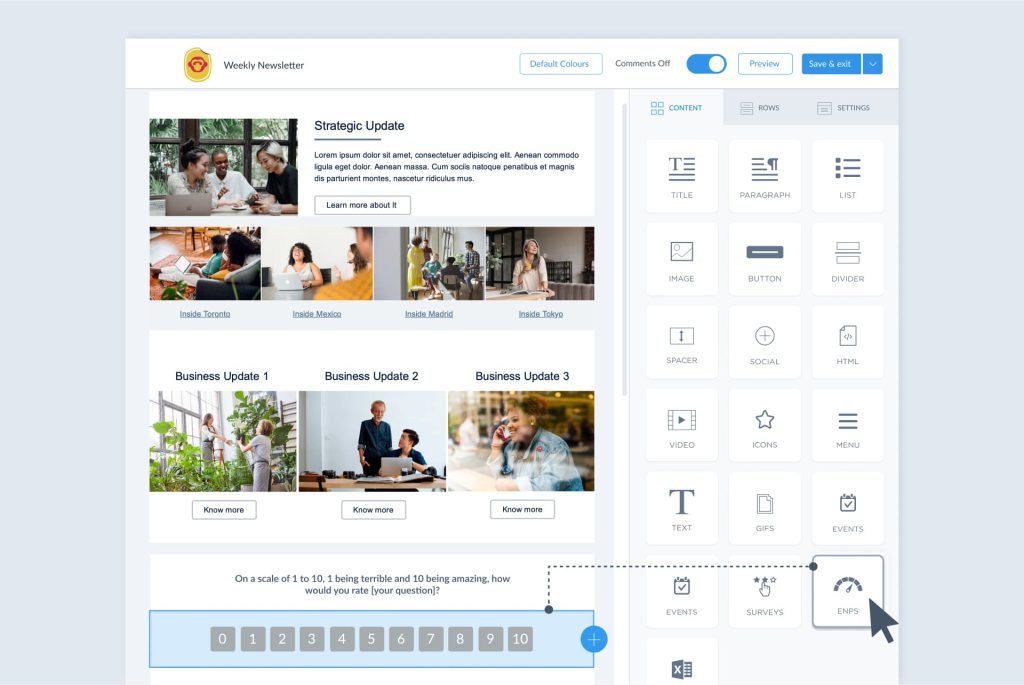
- Use pulse surveys to identify specific issues with engagement and to get direct feedback as to how these issues can be addressed.
- ContactMonkey offers detailed analytics and segmented reporting, which allows you to understand engagement across different roles, departments, and locations.
- You can also run detailed campaign comparisons. This will help you track changes in engagement over time, make sure that your strategies are working, and course correct quickly if engagement starts to fall.
Get powerful send features with ContactMonkey
Create custom audiences, increase content relevancy, and improve employee email engagement.
Learn more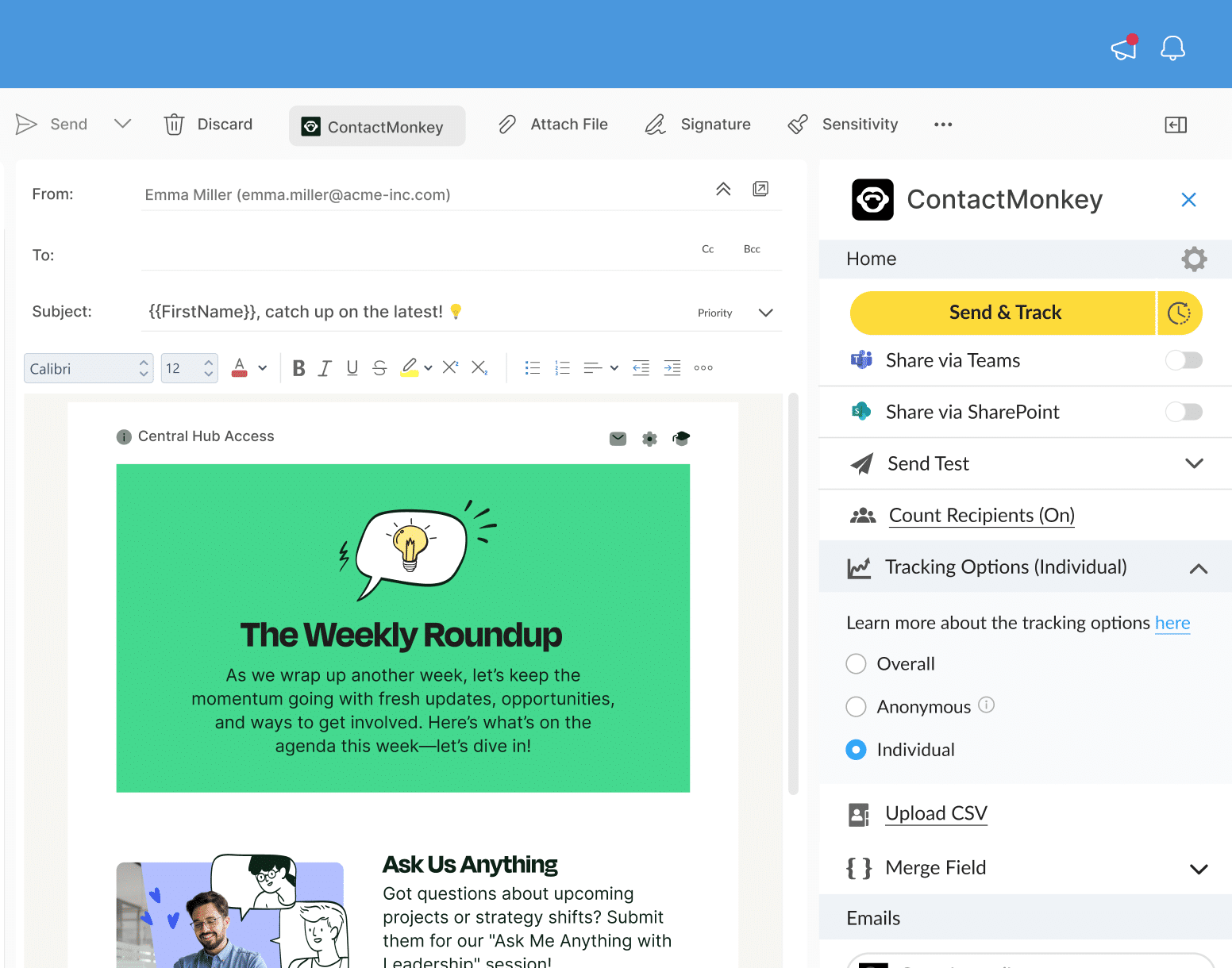
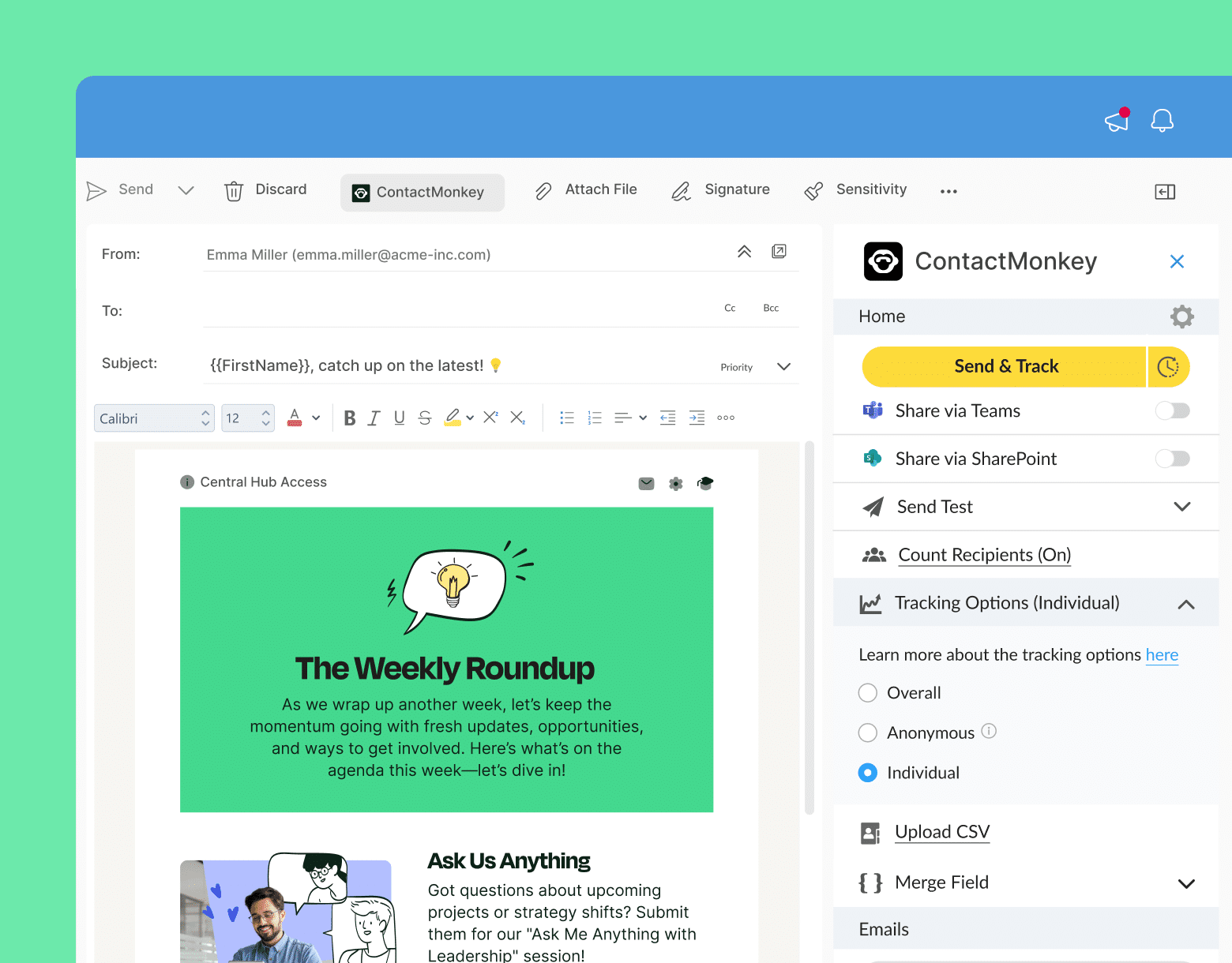
10. Poor onboarding communications keep new hires from settling in
A new hire’s first three months are crucial to their success, and facing internal communication challenges during those crucial months can derail everything. If a new employee doesn’t receive sufficient support, experiences delays or gaps in access, or must constantly chase down important resources on their own, they may never feel completely comfortable in their role, even months in.
Solutions:
- Create a clear, step-by-step onboarding plan including pre-made templates that can be sent to every new hire. Work with team leaders on team-specific onboarding templates.
- Distribute or consolidate onboarding communications via a single channel that employees can easily access and search for information. We suggest using email as an internal communication channel when sharing resources that employees will need to return to.
- Make it easier for new hires to integrate socially as well as in the scope of their role:
- Introduce the new hire or have them introduce themselves with a new employee introduction email.
- Organize a buddy program or virtual watercooler chats to introduce new hires to team members.
- Send out check-in survey(s) to employees 1-3 months in to identify any struggles and get feedback on and refine the onboarding process.
How ContactMonkey Can Help:
- With ContactMonkey’s customizable employee onboarding templates, you can organize onboarding info and resources into clear and responsive emails that new hires can reference again and again.
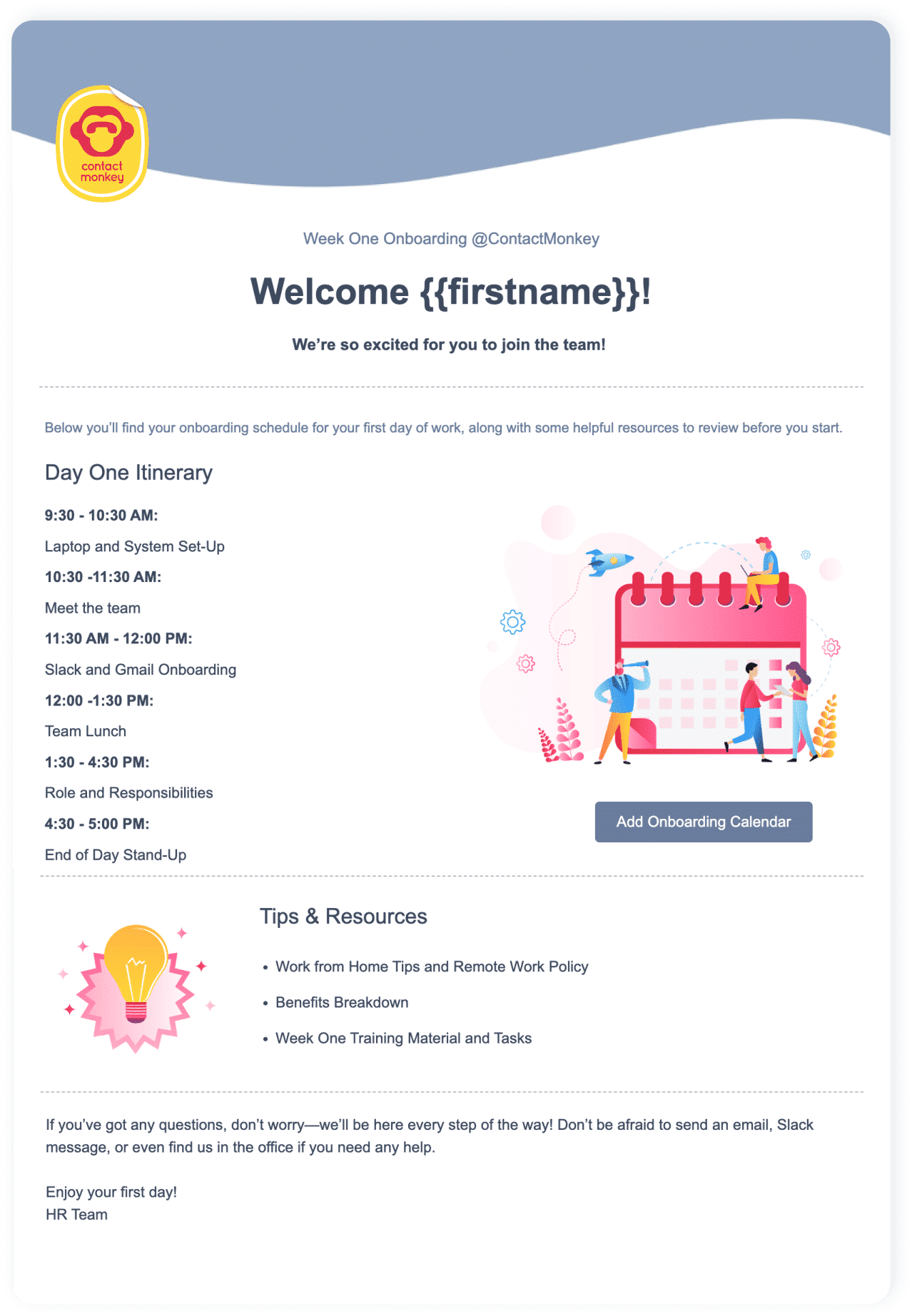
- Create templates for recurring onboarding communications, including first-day information, scheduled check-ins with new hires, and company-wide welcome emails.
- When a new hire joins, create a new email from the template, make any necessary edits (such as adding in specific starting dates, links to updated policies, and employee coaching schedules), then send off your onboarding information email within minutes.
- Include merge tags in your email to automatically personalize it for new employees.
- Use email analytics to understand how new hires are engaging with your onboarding emails.
- Include pulse survey questions in your onboarding communications to get immediate feedback from new hires.
11. Information silos keep employees from accessing necessary knowledge
Information silos happen when data is compartmentalized or restricted to specific departments or teams, making internal communication a challenge between teams. Members of different teams don’t communicate and don’t make their data available to other parts of the company, leading to pockets of knowledge being isolated throughout the organization.
This lack of integration can result in inefficiencies, duplication of efforts, and hindered collaboration among employees. Without a solid flow of information between departments, your business may ultimately witness an internal communication breakdown and even outright conflict between departments.
Solutions:
- Implement a central knowledge management system and develop a comprehensive knowledge-sharing strategy to ensure data is accessible across departments.
- Make use of Slack groups for interdepartmental sharing and company-wide virtual town halls to improve cross-department communication.
- Have a synchronized channel for company-wide news.
- A company newsletter ensures that your IT team is consistently in the loop about your sales team’s projects and the sales team knows all about what’s happening in marketing. It can also help employees identify opportunities for cross-team collaboration.
How ContactMonkey Can Help:
- With Microsoft Teams integration, you can push internal newsletters directly to your Teams channels to create a central archive of company-wide news.
- Create email templates for team updates or add a team update section in your regular newsletter template.
- Use survey tools to solicit feedback from employees on identified gaps in knowledge-sharing.
Start two-way conversations and employee feedback loops
Learn how to engage staff with pulse surveys, content ratings and reactions, custom polls, and more. Ready to send modern emails?
See engagement features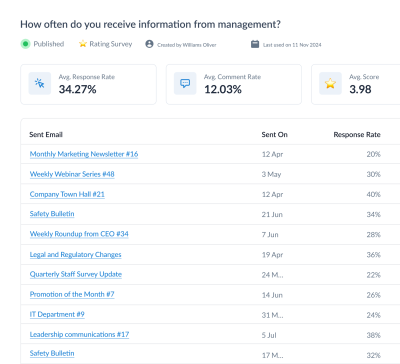

12. Lack of employee recognition makes employees feel undervalued
Employee recognition is essential in keeping your teams motivated and engaged. When hard work is recognized, it lets employees know their efforts are valued. If employees feel unseen, their motivation starts to plunge and performance quickly follows suit.
Solutions:
- Provide consistent opportunities for leaders and employees to acknowledge and give kudos to team members. For example, create a Microsoft Teams or Slack channel for giving kudos, add an employee spotlight to your regular newsletter, or give employees a space to thank their team members at all-hands meetings.
- Offer employees tangible rewards when they perform well, such as a bonus, an outing, or a paid lunch.
How ContactMonkey Can Help:
- ContactMonkey’s drag-and-drop email template builder lets you embed images, email tables, GIFs, and even videos to turn your next newsletter into an employee wall of fame.
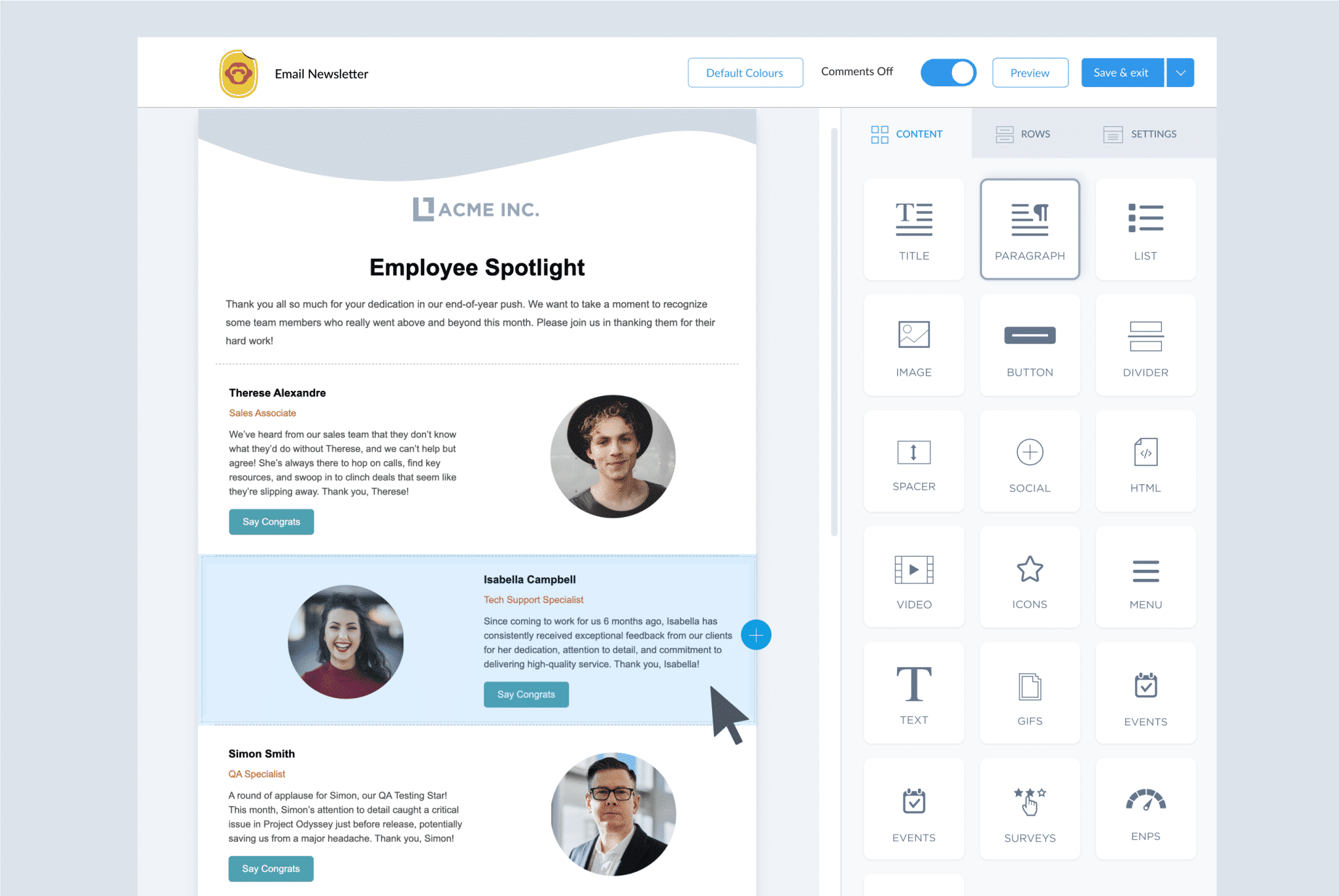
13. Productivity suffers as employees experience communication overload
Did you know that the average employee receives 120 daily emails? That’s on top of phone calls, group chats, text messages, and team meetings. There’s only so much information an employee can reasonably keep in their heads, and that’s not even taking into account how internal noise can be a barrier to communication as well.
Task switching is a huge time sink. With so many messages clamouring for attention, an employee runs the risk of spending more time reading and responding to communications than they do working.
Solutions:
- Add clear CTAs to communications so employees can spot action items immediately.
- Be brief and avoid jargon to give your employees as little to sift through as possible.
- If messages aren’t urgent, combine them into a single news blast that employees can peruse at their convenience instead of doing constant task switching.
- Combining news items into a single message also lets you clearly indicate which parts are most important, taking the cognitive load off of workers.
- Be strategic about sending time. Employees often open their email at the start of their day, and that’s also when they’re least burnt out, so consider scheduling sending for the morning rather than hitting send immediately.
How ContactMonkey Can Help:
- With ContactMonkey’s internal comms analytics, you can identify and adjust for communications overload in real time. Sending a lot of emails and seeing a drop-off in opens and clicks? Schedule any additional emails for the next morning when employees are refreshed.
- Create a news blast template, then duplicate it and add news items and links as they accumulate. When you’ve reached a critical mass of news items, send your news blast and track engagement with email tracking.
- Not only do templates make sending faster and easier, but they can also help you cut through communications exhaustion with visually pleasing design. Add visual cues to indicate priority, emphasize CTAs, and separate items into topics, as well as provide supplemental information.
14. Language barriers prevent effective employee communication
An international, multilingual workforce brings unique perspectives and skills to your organization, driving organizational success and helping employees navigate the idiosyncrasies of new global markets. However, managing a multilingual workforce is one of the great challenges of internal communication.
Language barriers can easily lead to misunderstandings, misinterpretations, and decreased productivity. Plus, having no team members who speak the same language or having to communicate through translation often creates a sense of isolation for a distributed workforce.
Solutions:
- Get internal resources like knowledge management systems or intranets professionally translated to ensure equal access to organizational knowledge.
- Recruit multilingual employees to bridge language barriers.
- Offer employees language training or offer incentives for employees who undergo language training.
How ContactMonkey Can Help:
- ContactMonkey’s multi-language email feature allows you to send a single email or newsletter in up to four different languages simultaneously. Different languages are included in a single email, allowing employees to select the language they wish to read the email in.
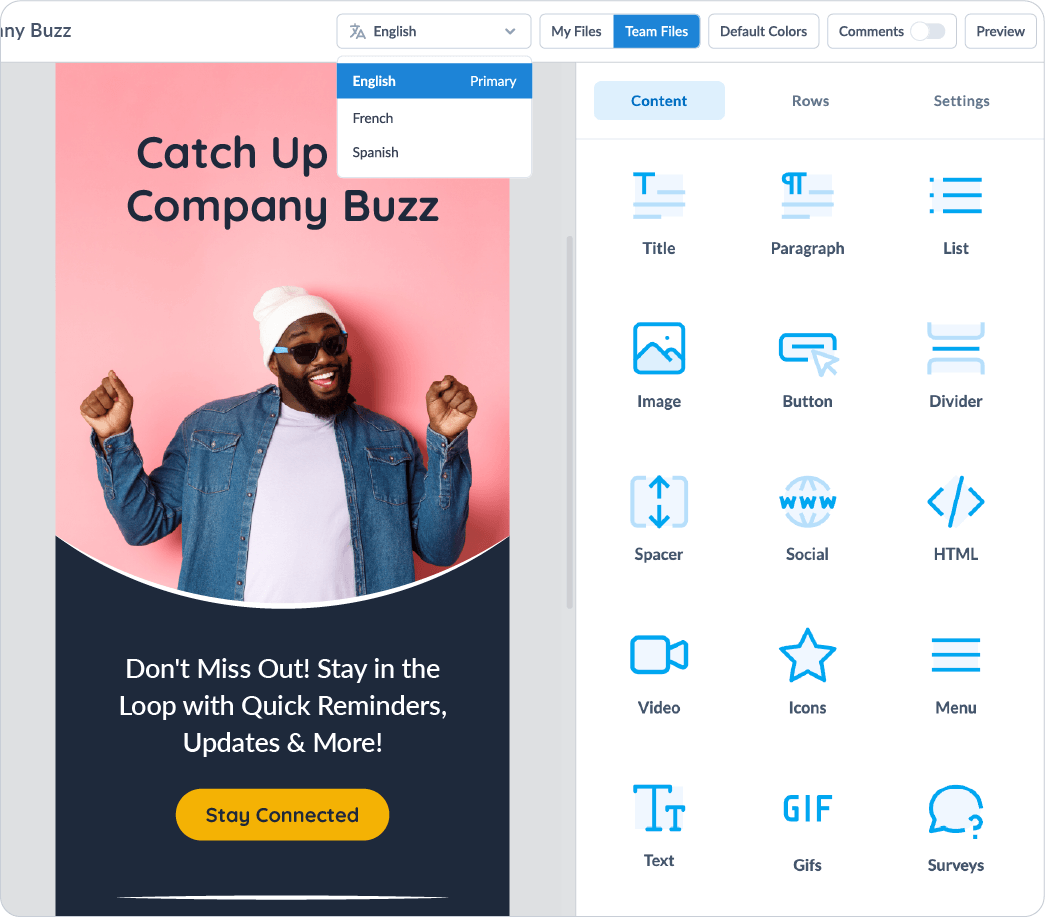
- If you’re sending out a message and need a translation solution quickly, ContactMonkey’s ChatGPT integration can help translate your content into other languages. Simply paste in your content, and prompt the AI assistant with your desired language. This way, you can send emails in multiple languages in a single campaign via the ContactMonkey platform.
15. No crisis communication plan means the company and employees are exposed to unnecessary risk
From inclement weather, fire, and pandemics to data breaches or PR disasters, crises occur when they’re least expected. When they do, unprepared businesses scramble not only to problem-solve but also to communicate those solutions to employees.
In a crisis situation, internal communication barriers don’t just have adverse effects on the business but pose real risks to employee wellbeing.
Check out these crisis communication case studies for more information on how to get an excellent plan in place.
Solutions:
- Be proactive. Prepare a comprehensive crisis communication plan that’s easily accessible to all leaders, stakeholders, communicators, and employees.
- Lay out individual responsibilities in the event of an emergency, as well as the appropriate channels for crisis response communications. Make sure employees know who their point of contact is and what channels to check for further instructions during a crisis.
- Create templates for common crisis communication types like office closure and inclement weather notices.
- Leverage multi-channel emergency notification systems to send crisis comms across multiple channels and track engagement to make sure communications are being received.
How ContactMonkey Can Help:
- Use ContactMonkey’s email template builder to create basic crisis comms templates that can save you time in an emergency.
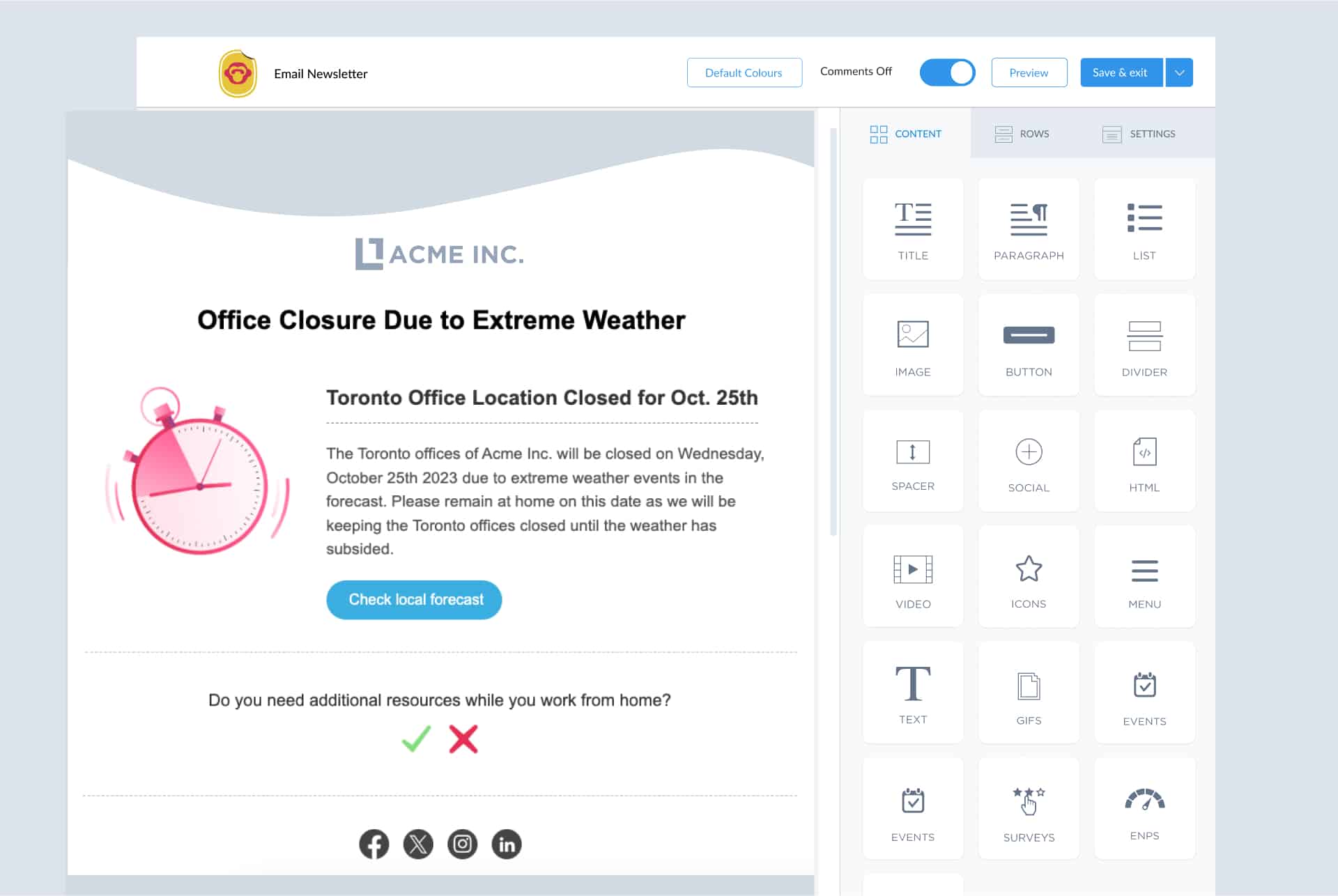
- Use ContactMonkey as an emergency SMS alert system to reach employees quickly and wherever they may be, whether at home, in the office, or on-site.
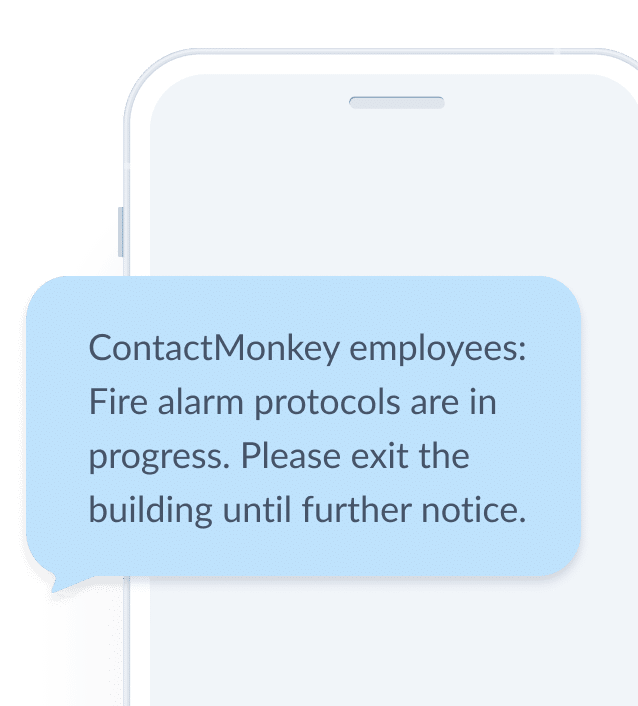
How To Overcome Internal Communication Problems With ContactMonkey
Corporate communication challenges are a regular part of an organization, but they don’t have to turn into company-wide internal communication issues.
By putting internal communications best practices in place and making use of corporate communication solutions like ContactMonkey to track how employees engage with content, you’ll be prepared to face the common causes of problems in internal communications. When issues arise, you’ll have the tools to get your business back to running smoothly.
Learn how to use internal communications software to track communications and spot problems fast. With dynamic design and embedded employee feedback features, you can continuously improve your internal communications.


